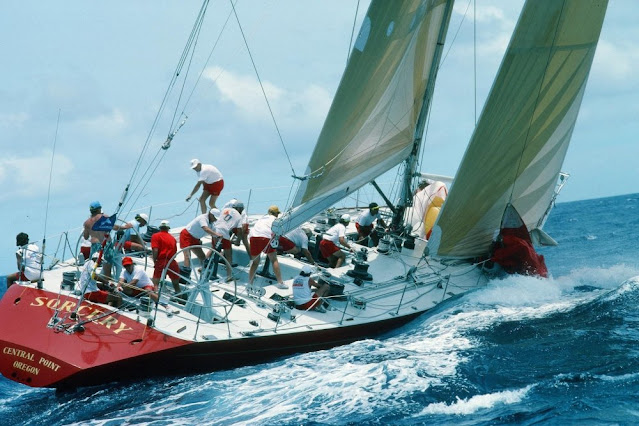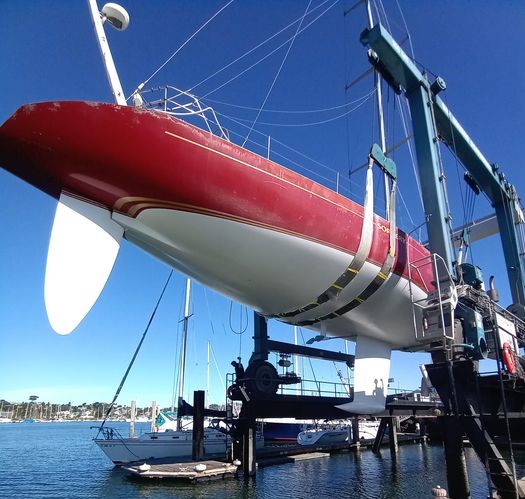 |
| The IOR 50-footer Abracadabra powers across a startline during the 1987 Big Boat Series (photo Phil Uhl) |
The St Francis Perpetual Trophies Regatta, which became known as the Big Boat Series, was an annual regatta hosted in San Francisco Harbour by the St Francis Yacht Club, first run in 1964. After the unprecedented cancellation of the 2001 edition of the series, Latitude 38 magazine published a retrospective on the regatta, which itself was an update of its September 1993 article titled '30 Years of the Big Boat Series - Thanks for the Memories'. I have combined this overview of the results for the 1985-1990 period and have included a 'Sail' magazine article covering the 1985 regatta and some spectacular photos from Sharon Green, Guy Gurney and Phil Uhl. An earlier article featuring the 1978-1984 regattas can be seen
here.
 |
| The Reichel/Pugh 43-footer Sidewinder sails downwind in typically fresh conditions during the 1985 Big Boat Series (photo Sharon Green | Ultimate Sailing) |
The 1985 Big
Boat Series demonstrated once again that it pays to have a new boat, but not
too new. The regatta, held from 15 to 21 September, featured five class winners (amongst the 54-boat fleet) that were recently built but had enough miles for rethinking,
redesigning and rebuilding. The Reichel/Pugh 43 Lobo was sailing on its
second keel, as was the Nelson/Marek 49 Crazy Horse, which was also on its
seventh rudder.
 |
Coyote in a hotly contested fleet of 40-footers, with Bondi Tram visible to leeward (KA-806) during the 1985 Big Boat Series
|
The 1985 edition
was also notable for the support of the ‘new’ One Ton class, with only 0.3ft of
rating separating the 15 smallest 40-foot boats, racing for the Rheem Trophy in
a class that included ten One-Tonners and featured the toughest competition of the week.
Constant changes in fortune kept the outcome in doubt until the final day, when
a second place for John MacLaurin’s Davidson-designed Pendragon put them ahead
of the Andrews 39 Impact. The Beneteau 39 Coyote (Irving Loube) and the Farr 40 General
Hospital were close behind.
 |
| Fujimo leads Carat and Blade Runner during the 1987 Big Boat Series (photo Guy Gurney) |
The San
Francisco sea-breeze funneled in over the race area like clockwork, building to
over 20-knots each day. Early races were sailed entirely on flood tides, which
put a premium on upwind speed. This was no problem for Lobo, skippered by Tom
Whidden, which won three races and Keefe-Kilborn Trophy, and edging out the
Reichel/Pugh 42 It’s OK and the Nelson/Marek 41 Clockwork.
 |
| Abduction runs downwind alongside Lobo, seen here during the 1987 Big Boat Series (photo Phil Uhl) |
Two members of
the 1985 US Admiral’s Cup team competed against eight other boats for the
Atlantic Perpetual Trophy. After a rushed trip to California from England, Bill
Power’s Nelson/Marek 43 High Roler set the pace, winning three races to
lead from the Frers 43 Shockwave and fellow team boat Sidewinder, a Reichel/Pugh
43. Meanwhile, Crazy Horse won four straight races in the City of San Francisco
Trophy. She was the third lowest rating boat in a class of ten boats with a rating
band of 10.7ft. The flood tides gave the bigger boats more time to work clear,
but on the Bay, courses are tight, with short legs and turning marks that come
around nearly as soon as a sail can be packed. That kept Crazy Horse within
striking distance of quicker yachts such as the Soverel 55 The Shadow and the
Frers 50 Tomahawk (second). The 1984 winner of this class, Blade Runner, was
third.
 |
| The amazing spectacle of the Big Boat Series in the late 1980s captured here by Sharon Green (Ultimate Sailing) - left to right Cadenza, Shockwave, Camouflage, Blade Runner and Mauni Lani Flash |
 |
| Blade Runner with her colourful spinnaker and blooper set and backlit by the Californian sun during the 1987 Big Boat Series (photo Phil Uhl) |
The 1986 series
featured 53 boats. Gary Appleby's Farr 40 Sagacious came up from
Australia to win the subjective 'overall boat of the series', a new award;
bumper stickers and buttons proclaiming 'Shit Happens' made their first
recorded appearance; Shockwave's 'Twisted Sisters' set a torrid fashion
pace. IOR I - Infinity; IOR II - Roller; IOR III - Sleeper; One
Ton - Sagacious.
 |
| Carat VI sails downwind during the 1987 Big Boat Series, with Locura visible to the left (photo Phil Uhl) |
 |
| Another shot of Blade Runner, seen here on a reaching leg during the 1987 Big Boat Series (photo Phil Uhl) |
 |
| Carat VI (left) and Fujimo during the 1987 Big Boat Series (photo Phil Uhl) |
In 1987,
contested by 45 boats, Pendragon won the 'overall performer' award
(dropped after this series); Peter Stocker lost a bet and picked up the dinner
tab for the Blade Runner, Bondi Tram and Sidewinder crews at
Mulherns, probably the most expensive Big Boat Series dinner ever. General Hospital
was dismasted in front of the clubhouse. IOR I - Jubilation; IOR II
- Insatiable; One Ton - Pendragon.
 |
| Sidewinder (left) and Camouflage approach a windward mark during the 1987 Big Boat Series (photo Phil Uhl) |
 |
| Swiftsure leads Blade Runner downwind during the 1987 Big Boat Series (photo Phil Uhl) |
 |
| Another photo capturing the colour of top level racing in the 1987 Big Boat Series, with Fujimo seen here leading Swiftsure with Blade Runner further astern (photo Phil Uhl) |
 |
| The Soverel-designed 50-footer Locura running downwind wtih spinnaker and blooper set during the 1987 Big Boat Series (photo Phil Uhl) |
 |
| Part of the One Ton fleet in the 1987 Big Boat Series, General Hospital follows Sundance (left), with Bondi Tram just visible ahead (yellow blooper) and eventual winner of the division Pendragon leading (photo Phil Uhl) |
1988 was the
Big Boat Series' 25th anniversary, as well as IOR's last big hurrah in the US. Although
featuring a reduced entry of 38 boats, everything fell into place to make this
a fabulous event - it followed a maxi year at the Kenwood Cup and the One Ton
Worlds that were held two weeks prior on the Bay. Raul Gardini and Paul Cayard teamed up
on Il Moro to decimate eight other maxis with five bullets, while Tom
Blackaller called tactics on the victorious Farr 50 Great News against
nine hot 50-footers, edging out Royal Blue and Abracadabra. Blade Runner hooked a buoy with its lazy runner and
inverted her mast three feet, but it didn't break. The Peter Gilmour-driven
maxi Sovereign broke theirs, however. Maxi - Il Moro di Venezia; IOR
50 - Great News; IOR II -Shockwave; One Ton - Pendragon.  |
| Big Boat Series - The Shadow (Soverell 55) leads Checkmate and Jubilation (photographer unknown) |
 |
| A mighty battle occurred amongst a fleet of eight maxis in the 1988 Big Boat Series, though it was won convincingly by Il Moro di Venezia - here we see Congere leading Matador (US-33700), Sovereign and Windward Passage II in tight reaching conditions on the Bay (photo Guy Gurney) |
 |
| The bowman working in white water aboard Fujimo, trailing Insatiable, during the 1988 Big Boat Series (photo Guy Gurney) |
 |
The Vallicelli-designed 50-footer Springbok in power reaching conditions during the 1988 Big Boat Series (photo Sharon Green | Ultimate Sailing)
|
For 1989 it
was evident that interest had declined further, with entries reducing to just
24 boats, possibly the Big Boat Series’ darkest hour. Cadillac sponsored this series (the first time that sponsorship was allowed) and ESPN televised
it (with a heavy focus on the 50-foot and 70-foot sleds). IOR I - Shockwave; IOR II - Pendragon.
 |
| Sorcery in a close tussle with Matador during the 1988 Big Boat Series (photo Sharon Green) |
 |
| Bloopers as well as spinnakers kept the bowman busy during the 1980's - in this case Blade Runner during the 1987 Big Boat Series (photo Phil Uhl) |
The 1990 series
featured a whole new look, with the regatta shortened from its previous week-long
format to six races over four days. Two different courses were used for the
first time, and attracted 57 boats. The highly-touted IMS rule debuted to mixed
reviews, while IOR wheezed through its final death throes. Meanwhile, the rest
of the series quietly went one design. IOR I - Blade Runner, IOR II – Will.
 |
| More bowman action, again during the 1987 Big Boat Series (photo Phil Uhl) |


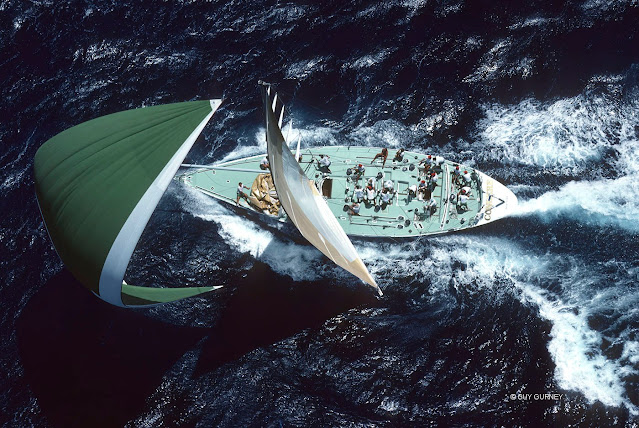

.jpg)



































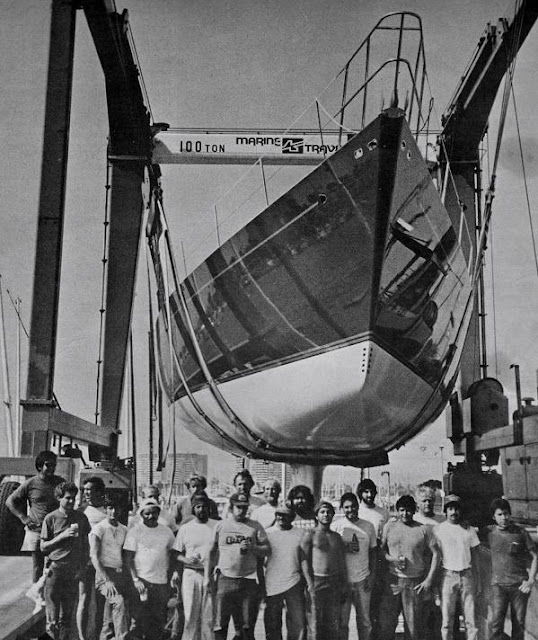
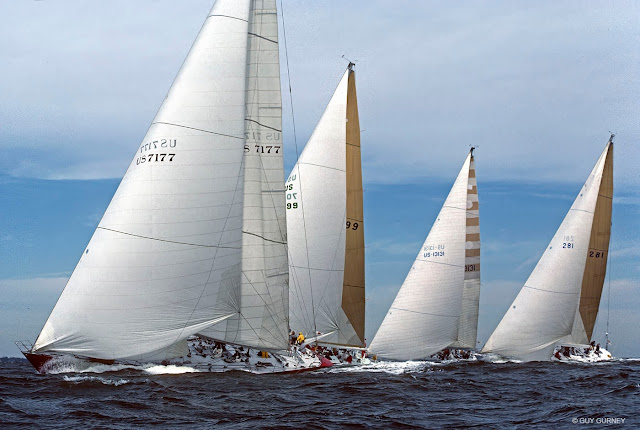












.jpg)

